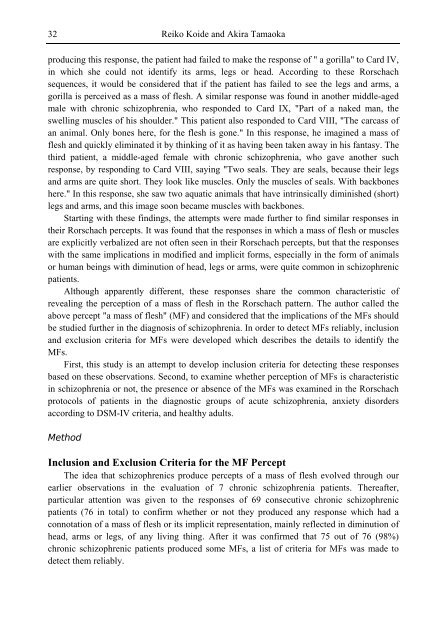Schizophrenia Research Trends
Schizophrenia Research Trends
Schizophrenia Research Trends
- No tags were found...
You also want an ePaper? Increase the reach of your titles
YUMPU automatically turns print PDFs into web optimized ePapers that Google loves.
32Reiko Koide and Akira Tamaokaproducing this response, the patient had failed to make the response of " a gorilla" to Card IV,in which she could not identify its arms, legs or head. According to these Rorschachsequences, it would be considered that if the patient has failed to see the legs and arms, agorilla is perceived as a mass of flesh. A similar response was found in another middle-agedmale with chronic schizophrenia, who responded to Card IX, "Part of a naked man, theswelling muscles of his shoulder." This patient also responded to Card VIII, "The carcass ofan animal. Only bones here, for the flesh is gone." In this response, he imagined a mass offlesh and quickly eliminated it by thinking of it as having been taken away in his fantasy. Thethird patient, a middle-aged female with chronic schizophrenia, who gave another suchresponse, by responding to Card VIII, saying "Two seals. They are seals, because their legsand arms are quite short. They look like muscles. Only the muscles of seals. With backboneshere." In this response, she saw two aquatic animals that have intrinsically diminished (short)legs and arms, and this image soon became muscles with backbones.Starting with these findings, the attempts were made further to find similar responses intheir Rorschach percepts. It was found that the responses in which a mass of flesh or musclesare explicitly verbalized are not often seen in their Rorschach percepts, but that the responseswith the same implications in modified and implicit forms, especially in the form of animalsor human beings with diminution of head, legs or arms, were quite common in schizophrenicpatients.Although apparently different, these responses share the common characteristic ofrevealing the perception of a mass of flesh in the Rorschach pattern. The author called theabove percept "a mass of flesh" (MF) and considered that the implications of the MFs shouldbe studied further in the diagnosis of schizophrenia. In order to detect MFs reliably, inclusionand exclusion criteria for MFs were developed which describes the details to identify theMFs.First, this study is an attempt to develop inclusion criteria for detecting these responsesbased on these observations. Second, to examine whether perception of MFs is characteristicin schizophrenia or not, the presence or absence of the MFs was examined in the Rorschachprotocols of patients in the diagnostic groups of acute schizophrenia, anxiety disordersaccording to DSM-IV criteria, and healthy adults.MethodInclusion and Exclusion Criteria for the MF PerceptThe idea that schizophrenics produce percepts of a mass of flesh evolved through ourearlier observations in the evaluation of 7 chronic schizophrenia patients. Thereafter,particular attention was given to the responses of 69 consecutive chronic schizophrenicpatients (76 in total) to confirm whether or not they produced any response which had aconnotation of a mass of flesh or its implicit representation, mainly reflected in diminution ofhead, arms or legs, of any living thing. After it was confirmed that 75 out of 76 (98%)chronic schizophrenic patients produced some MFs, a list of criteria for MFs was made todetect them reliably.
















